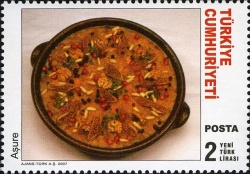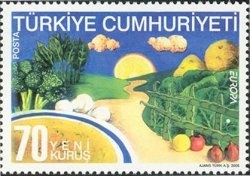My Country - Your Country: A Turkish Woman in Denmark
23. Sep. 2009
NN, who came to Denmark 17 years ago, is the mother of three children aged 3, 16 and 17. Her presentation is among other things showing food. The occasion is a Turkish postage stamp from 2007 featuring a picture of one of Turkey's oldest and most traditional desserts: Aşure.

Turkish stamp from 2007. ”Aşure” is one of Turkey’s national dishes.
NN relates: "This is a Turkish national dish which we only make in connection with the Eid festivities. It is a special dish which is made a month after the Eid. It is like when you in Denmark make rice pudding for Christmas. My sister is visiting and she helps me making the dish".
The Eid Festival
There are two annual Eid festivals. The first one - the small festival - celebrates the end of the fasting month, the Ramadan. In Arabic the festival is called Eid al-fitr. The word Eid signifies "festivities" whilst fitr means "to break the fast". In 2009, the Ramadan took place during the period from 22nd August to 20th September and, consequently, the small festival was celebrated on 21st September.
The Islamic calendar follows the moon which is why the first month is moving 11-12 days a year compared with the Gregorian calendar. A month begins when the new moon is visible in the sky and therefore the beginning of a month cannot be determined in advance.
The second Eid festival, which takes place two months and 10 days after the small festival, is called Eid al-Adha (the big festival) or Kurban Byram (the sacrificial festival). The month after the sacrificial festival is known as the Asjuré month when it is tradition to prepare the Aşure dessert.
Aşure
The special history of the dessert is connected to the narrative about Noah's Ark. According to Muslim tradition the prophet Noah and his family collected all the food that was left in the Ark after the Flood and made a pudding of it. The dish is therefore called Ashura or Noah's pudding.
In memory of the prophet Noah and as thanksgiving to God, Muslims has made it a tradition to prepare this pudding and share it with neighbours and friends. Sharing food is a symbol of human unity and mutual relations regardless of personal belief, background, and conviction.
NN follows the tradition in Denmark and shares the dessert with neighbours, friends and acquaintances that are taken sick. The ingredients appear from the recipe below, but the choice of nuts may be varied. NN uses "rice, raisins, pine nuts, walnuts, hazelnuts, sweet things, white beans and chickpeas. It can be served hot or cold with sugar."

Turkish European thematic stamp from 2005. The European thematic stamps feature different motifs from country to country, but they all share a common theme. In 2005 the theme was Gastronomy.
Food Culture
There is a big difference between Aşure and Danish rice pudding, but in other areas the Danes have embraced the Turkish cuisine, e.g. kebab, bulgur, rice pilaf, and köfte (Turkish meat balls). However, the culture around the food is different: "In Turkey visitors may arrive unannounced, especially at the Eid festival. It is not like that in Denmark. Here we make an agreement first". In Denmark both men and women are cooking contrary to Turkish traditions: "Turkish men do not cook. The women do". NN has learned from her mother how to cook.
A stamp depicting a dish can actually function as an ambassador and the starting point of a dialogue between two cultures. Just imagine what a Danish stamp featuring a bowl of rice pudding would be able to tell.
If you would like to try to make the dish on the stamp, here is the recipe for Aşure:
Ingredients
180 g dövme (de-husked wheat)
1½ tablespoonful rice
60 g dried beans
60 g chick peas
2½ l water
60 g dried apricots
60 g dried figs
50 g raisins
1 tablespoonful orange peel
300 g sugar
1 small orange (120 g)
1½ tablespoonful rose water
60 g walnuts
Preparation:
Wash the wheat, chikpeas and dried beans. Soak them separately overnight with beans and chickpeas in 2½ dl water and the dövme and rice mixture in 5 dl water. The next day add 7½ dl water to the dövme and rice mixture and 5 dl water to the chickpeas and beans mixture. Place the mixtures individually on the burner. Cook the dövme mixture until the grains are dissolved and the starch comes out. If necessary, boil the chickpeas in a pressure cooker.
Wash the dried fruits and soak them for two hours in 4 dl water. Mix the fruits and the cooked ingredients in a pan and cook for 15 minutes. Peel the orange divide the segments into 4-5 pieces. Add them to the mixture and cook for another 5 minutes. Add the sugar and cook for 1-2 minutes. Turn off the heat. Add the rose water and stir.
Pour the Aşure into dessert cups and garnish with walnuts. .
Source: A Selection of Turkish Cuisine, publication from the Turkish Ministry of Culture.
This article may be copied or quoted with MuseumsPosten, Post & Tele Museum as source.
Comment this article
Only serious and factual comments will be published.